We are a group of web hosting, web design, and online marketing experts who share the same goal — to help our readers build an effective online presence without breaking the bank.
To this end, we review dozens of products and services, including website builders, web hosting services, logo design services, email marketing services, freelance websites, project management software, payment processing services, and more. Our goal is to share our experience with you and to give you accurate information that you can then use to make informed decisions for your business.
To ensure a high publishing standard across all our reviews, comparisons, and guides, we use a robust testing methodology for each category of products we recommend. Our experts, writers, researchers, and testing specialists all adhere to these strict methodologies, and their independent evaluations inform all of the reviews we publish.
To maintain our website and support the work that goes into our in-depth reviews and guides, we may earn a small commission when you sign up for a service through a link on our site, at no additional cost to you. This doesn’t influence our opinions, which are always based on thorough research and testing.
We test and rate each site builder based on the criteria below. These criteria are meant to help you, our reader, better assess whether a website builder is the best choice for your needs and level of experience.

Templates
The whole point of using a website builder is to save you the trouble of creating a website from the ground up. With this in mind, the first thing we evaluate when testing a website builder is its templates. A professionally designed template should be a highly customizable starting point from which you can build your ideal site.
Templates are also meant to represent a builder’s best qualities, so a selection of janky, messy-looking templates is a sign of a low-quality editor. We also make sure that every template is at least somewhat mobile-responsive. More than half of all web traffic happens on mobile devices, so a builder with poor mobile responsiveness is one that will lose you a considerable number of visitors.

Finally, we take variety into account. A varied selection of well-categorized, niche-specific templates means that you’re more likely to find something that approximates your vision.
Occasionally, we also review website builders that don’t offer traditional templates. Instead, they offer some automated tools that generate personalized “templates” based on your preferences. The very best builders often offer both traditional and custom-generated templates.
Features
Any builder lives and dies by the quality of its editor and the features it gives you access to. It’s not hard to find a builder that lets you publish a blank page with some text and maybe a couple photos, but a quality editor should offer a lot more than that.
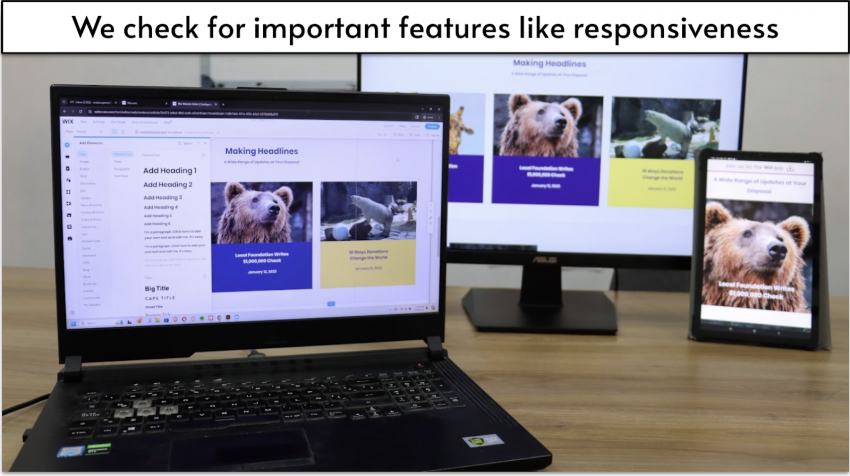
We start by evaluating the type of editor that a builder offers, and the degree of versatility it provides. Can you drag and drop elements wherever you like, or must you arrange them in a grid? Do you add elements as part of pre-configured content blocks, and if so, how customizable are these?
Not every builder needs to be filled to the brim with uber-specific features, but we expect to see a well-rounded selection of tools for the type of user it’s aimed at, whether that’s complete beginners, those looking for maximum design freedom, or people requiring specialist features for things like portfolios or e-commerce.
We also pay close attention to the overall user experience. We’re likely to score a builder higher than another with similar features if it’s more enjoyable to use.
As a bonus, we take any and all specialized features into account. If a builder offers robust options for e-commerce, SEO, blogging, marketing, or anything else, that is bound to earn it additional points.

Ease of Use
Every website builder must allow its users to build a functional website, even if they don’t know how to code or have never built a website before. And although the most versatile builders have more of a learning curve than others, even these should offer a great balance of features and ease of use. It’s our belief that with some time and dedication, anyone should be able to master even the most feature-rich website builder.
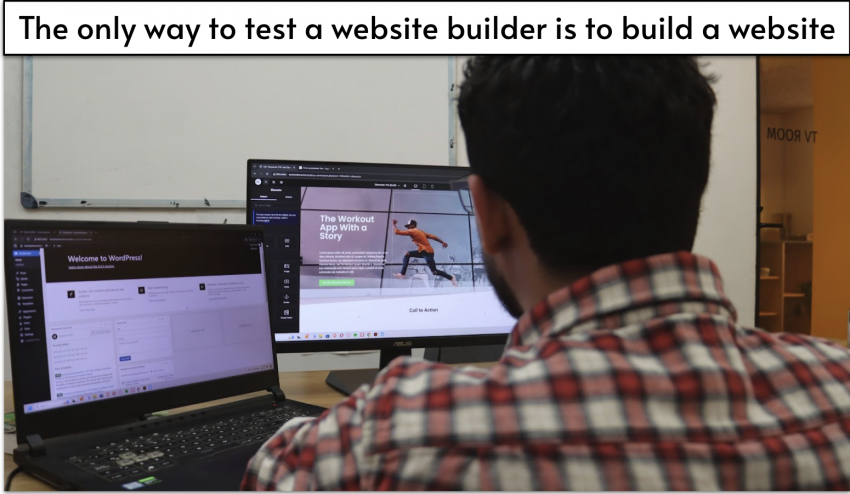
It’s also very important to us that any learning curve is well plotted. In other words, while it might take a while to get the hang of the most complicated tools that a builder offers, it should always be easy to create a basic page.
The learning process should also be well supported. We tend to dock points from builders that leave you on your own with no explanation of how to start. Conversely, we award points to builders that offer well designed “getting started” tutorials that guide you through the basics.
Finally, if a builder does offer specialized features, these should be optimized for user-friendliness as well. For example, if a builder offers e-commerce functionality, the e-commerce panel should be easy to navigate and understand. The same goes for any tools for SEO, marketing, content management, and so on.

Pricing
The promise that “website builders allow anyone to build an online presence” stops ringing true whenever a given website builder is prohibitively expensive. Once again, we value balance.
Some builders might offer pricier plans, but these should always offer the quality and features to justify their price, allowing them to be thought of as more of an investment than an expense.
We’ve often favorably reviewed website builders with high-priced plans, but never if that’s the only price available. A quality builder should offer a range of plans that target a variety of users, including at least one affordable option.
We do not tolerate lackluster standard plans. If you’re paying any amount of money for a website builder, you should be able to create a functional, high-quality website. On the flip side, a lot of builders offer free plans or free trials. While these are seldom suitable for building a professional site due to branded sub-domains, restricted bandwidth, and advertising, they should still allow you to create a fully-functional website to win points in this category.
We also subtract points for shady business practices. This includes fake discounts, hidden costs, and constant upsells.

Support
It’s only natural that you’ll come across some questions when using any website builder. When this happens, it’s important that you have access to a helpful and efficient support line to get answers quickly.
When evaluating a builder’s support, we start by taking the numbers of support channels into account. The more, the better. We also consider their hours of availability. Seven different lines of support are of little use if you can only contact them on the second Monday of each month between 9:00 and 9:10 am PST.
If a builder offers at least one line with 24/7 availability, that earns it bonus points, but we’ve had great experiences with builders that only provide support within (reasonable) business hours.
We test the customer support of each builder we review multiple times. It’s important that the experience is not only helpful but also pleasant. Ideally, the support staff will demonstrate a deep knowledge of the builder and explain complex concepts in simple terms with a friendly tone.
Finally, we pay close attention to response times. No one likes to “stay on the line while we get the next available agent” for twenty minutes. The fewer hurdles we have to go through before getting a satisfactory answer to our question, the more points we award.
We test and rate each web hosting service based on the criteria below. These criteria are meant to help you, our reader, better assess whether a web host is the best choice for your site, your audience, and your business.
Features
Web hosting services are offered in a competitive marketplace, and as a lot of vendors tend to offer the same feature sets, even just one unique feature can give a hosting provider an edge in a comparison.
Resource allocations are often the first thing a potential customer looks at, as this is a good way to measure the value of a hosting plan. How much storage is provided, and is it HDD, SSD, or SSD NVMe? Is there dedicated CPU or RAM, and if so, how much? How much data transfer is allowed in a given month, and what is the maximum speed of transmission? How many of any resource do you really need if you’re just starting out?
Security is of the utmost importance, as the complexity of even the simplest WordPress-based blog sites can offer many weaknesses for malicious bots. Is there a firewall, malware scanning, DDoS protection, and email spam protection? Is this AI-driven? Is it a proprietary security suite? Can the vendor offer anything that most others don’t?
Offering a choice of data centers allows customers to host sites nearer to the intended target audience. But how many data centers are available, and where in the world are they located? Does the customer get access to a content delivery network (CDN) that will expedite loading of site content in locations further away from the chosen data center?
What kind of web server software is used? The traditional Apache, or Apache with an NGINX reverse proxy? LiteSpeed, which offers optimizations for PHP-based CMSs? Does the vendor offer Windows or MacOS-based operating systems aside from the usual Linux? Which Linux distributions are on offer? What versions of PHP are supported?
Most web hosting providers offer support for WordPress, as it’s the most popular content management system (CMS) in the world. But some customers will be looking to run Magento, Joomla, Drupal or any number of other applications. Are these supported, and is there an installer? Is there access to a free and/or proprietary website builder and/or premium WordPress themes that are exclusive to the vendor?
Are there any performance-enhancing features, like caching or autoscaling? Are they proprietary?
Finally, just about every web hosting provider will offer free website transfers if you agree to purchase its services. Does this involve actual hands-on assistance, or is it just an online tool that you have to figure out on your own?

Ease of Use
While we at Website Planet will often review vendors that serve developer-level users or enterprise-level clients, we always keep the beginner user or solo freelancer in mind when we sign up for a plan from a given vendor, and we approach our testing as though we are new to web hosting.
First, we document and evaluate the purchase and sign-up process, and consult with technical support if there are any problems (see Support below). We document any notable extra fees, upsell attempts, or difficulties with the sign-up interface, as well as any useful or innovative interface elements.
Second, we connect a realistic domain name, either within the vendor’s own interface if it is included, or from a separate registrar.
Third, we typically install WordPress, unless the particular review requires some alternative CMS (or no CMS at all). As WordPress installation and configuration is often part of the setup process, we document this, and report on the results.
Finally, we note all the default features of the installation, and any notable features that have been enabled by default — such as caching, lazy loading, or SEO tools. Then, as a beginner to hosting might, we go on to set up a website with a pre-built theme, without making any unnecessary modifications to this default state. The website we set up during this phase is the website we test for the Performance section.
Performance
Robust performance testing sets Website Planet apart from competitors’ websites. We use a sample website page built from a theme that we’ve acquired from a commonly-used premium theme provider, with plenty of text, images, and graphics on the front end, with HTML, CSS, javascript, and custom fonts loading in the background.
All elements on the sample page are finely curated to total approximately 1 MB in size. Images are standard JPEGs that haven’t been compressed more than they were when they were included with the theme.
We may detail any performance-related features that were touched upon in the Features section above, or we may introduce these for the first time in this section, depending on their importance to the testing phase.

We begin our testing with hourly, automated GTmetrix tests for at least one week to get a realistic sense of how the vendor’s infrastructure performs during busier and less busy periods. These results may also provide suggestions for optimization that we can then pass on to the support team in the next section.
We run a global loading test from multiple locations with Sucuri Load Time Tester to get a sense of how the site performs around the world, but we acknowledge the location of the data center and whether or not a content delivery network (CDN) was enabled by default.

Our last test is uptime monitoring for a minimum of one week using UptimeRobot. We then compare the results to the vendor’s uptime guarantee, if any.
If it isn’t practical to run tests, we’ll evaluate the performance features offered by the vendor to establish whether a site should load well, and we’ll communicate with the pre-sales support team and research online comments and other reviews to back this up.

Support
We contact the vendor’s support team posing as ordinary users with legitimate questions or requests for help. We don’t ask about things that can easily be found on the site, or that readers won’t find helpful.
We establish all the available support channels on offer from each vendor, and whether they are available outside of regular business hours or not.

Then, we communicate with the support team using more than one available channel, if possible, and document the results. Were the support agents prompt, helpful, and/or knowledgeable? We provide examples of our interactions as well so that readers know what they can expect if they choose a plan from a given vendor.
Finally, we evaluate any self-help options, such as blogs, knowledge bases, or user forums, and we report on how useful, up-to-date, and clear this information is.

Pricing
We present an overall impression of the vendor’s pricing. Is it a budget or premium host, or does it offer a range of plans that could be classified under both of these categories? Are the prices competitive within these categories, or for the specific type of plan?
We summarize the various types of plans on offer, and highlight the best or most notable offers, in particular the one we tested in the Performance section above. We also attempt to simplify the plan pricing for the reader to make it easier to follow. Is the cheapest plan too basic to be worth considering? Are there essential features that are only available in higher-tier plans? What are the advantages to a longer-term commitment over a monthly plan, and is a monthly plan even available?
Is there a trial period or a money-back guarantee? How does it compare to the rest of the industry?
While we do reward budget-friendly prices in our rankings, we prefer to focus on overall value for money, so a premium vendor with higher prices that offers a significantly better service can rank higher than a budget vendor with few notable or unique features.
We rank each logo maker (or logo design service) based on the scope and quality of its functions, how easily you can create your own logos, the cost and value of what you get, and how reliable customer support is.
Features
The best logo makers have powerful tools that let you create unique logos with little to no design experience. We grade logo design software on its design and customization capabilities. That means a big icon library with a wide variety of themes to suit any business type will get a good rating. We’ll offer bonus points if a logo maker lets you create animated logos and/or gifs.
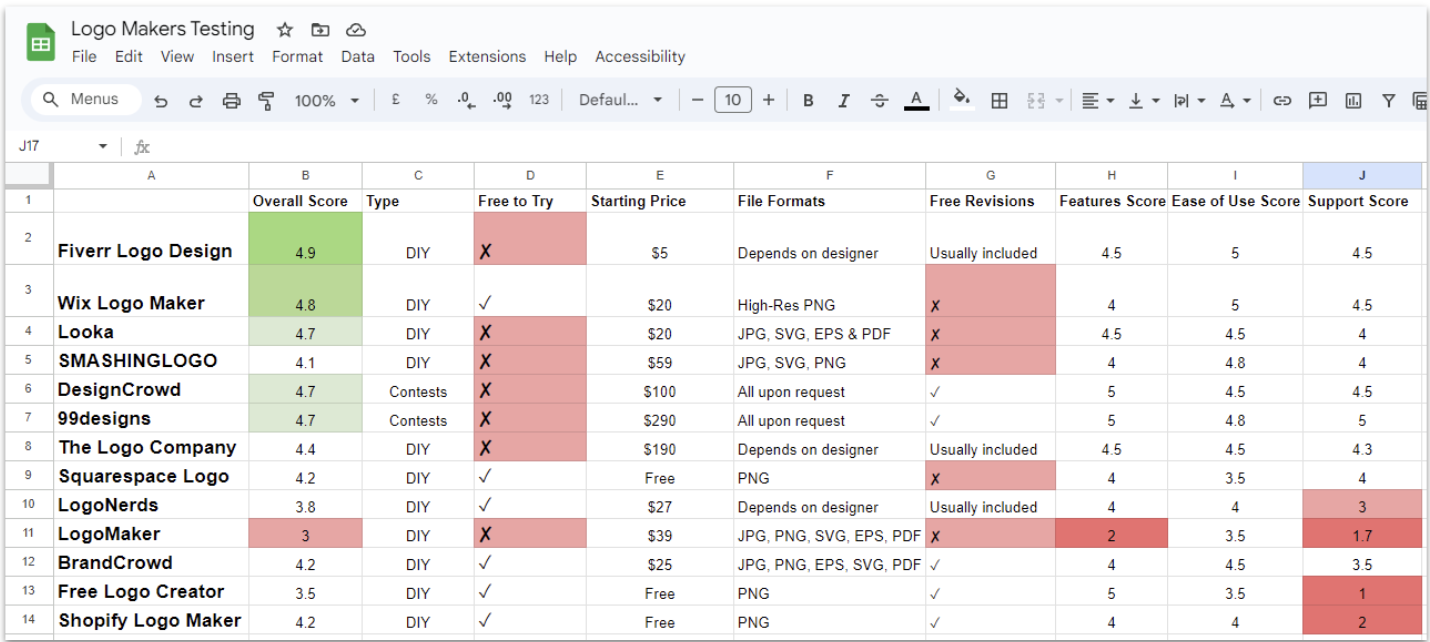
We check to see if logo editing features include the ability to add shapes, text, and backgrounds as you please. The more you can customize font, color, and color gradients, the better. A powerful logo editor means you can add more variety to your design and end up with a logo that stands out. It also makes it easier to use the same fonts and colors throughout all your branding.
Logo templates should be stylish to start with, as well as customizable to fit your needs. Bonus points if the software lets you work with a designer for a custom logo. Of course, this costs extra and needs to be factored in.
AI-powered logo designers are great for personalizing a logo to your desired style and branding. We give multiple prompts to ensure AI wizards work just as well (if not better) than creating a design from scratch or a template.
Finally, we want to be able to test the logo before buying it. We like it when logo design software offers free samples (a low-resolution download) that you can plug into your website or branding to see if you like the final look.

Ease of Use
The whole point of using logo design software is to get a logo without the hassle of drawing one or spending tons of money on an artist. As such, the process should be fast and easy. So, how do we test how easy a logo maker is to use? Simple: we use it from start to finish.

Signing up for a logo designer should be doable in a few simple steps. We look for quick account creation via your email, Google, Apple, or social media account. Some logo makers will let you use their editors without creating an account (only requiring one when it’s time to pay or download). We love to see a logo editor that’s free to try.
Search filters are how you find templates, themes, and icons that fit your business and brand. We test how advanced a logo maker’s search filters are. Bonus points are awarded when a logo maker successfully uses AI to select the right icon and layout for you. The key word being successfully, because the AI wizard is pointless if it gives you a buffet of unusable designs.
We then create multiple logos with each software’s editor. Are the customization options easy to find? Is there a drag-and-drop editor? If so, how well does it work? We answer all these questions to determine how fast and easy a logo maker truly is.

Pricing
Everyone has their own budget, so we consider all price points of logo design software. We like to see free logo makers, but we also check for limitations that come with free versions (like fewer functions or low-resolution downloads).
If a logo designer costs more than its competitors, we want to make sure it’s actually worth the cost — do you get more editing options, better support, and/or custom templates? If an expensive plan doesn’t give you significantly better features than other plans, we take off points. And if a logo maker has great value for what you get, we give it a higher rating.
It’s important for logo design software to give you multiple pricing options to cover every budget. If you have a bigger budget, you should be able to pay more for a better logo. If you’re on a tight budget, you should still be able to get what you need at a good price. Whatever the price point, we want to see good value for money.
Sometimes a logo maker will offer add-on services. We examine add-ons to determine if they’re actually worth the extra cost, or if they should have been included in the base price. Pointless upsell tactics mean fewer points from us.
Finally, we examine a logo maker’s refund policy and money-back guarantee. We’re big fans of refunds for when you don’t like your product or you get a corrupted file. If all sales are final, we’ll give you a warning and dock points off the logo designer.

Support
Ideally, you’ll be able to create a logo without needing support. But if you do run into a technical issue or have a design question, good support will answer you in a timely manner and give you the correct information.
The first thing we look for is the logo software’s support options. There should be a ticket system at the very least, but we award extra points for email, phone, and live chat available at a wide range of hours (preferably 24/7). We dock points if anything major is missing, such as a total lack of live chat.
We look for documentation, tutorials, video guides, and forums provided by the logo design platform. Documentation is great because it lets you look up how to’s and solutions without having to wait for a response from a support agent. It should be extensive enough that you can find the answer without having to look elsewhere.
Next, we reach out to a logo maker’s customer support team with questions and problems we need solving. If they offer multiple support channels, we’ll test as many as we can. Response time is extremely important to us. Not only do we compare whether a service really does offer “24/7 support”.
Finally, speed isn’t everything. We rate a support agent’s response on how well they answer our questions. If we get short answers, no solutions, or responses that flat out ignore our questions (it happens!), we award fewer points. We give more points when responses are clear and agents are helpful.
From importing contacts for the first time to designing an email from scratch, we score every email marketing service on each of the following areas. We then take all of these sections into consideration to calculate the overall score.
Features
A feature-packed EMS will consistently score better than an EMS lacking in core features that improve the email marketing experience.
The first — and most important -– feature we consider is email creation. We test each platform to make sure crafting good-looking, attention-grabbing emails is as easy as possible. We look at the number of available templates, the overall quality of the designs on offer, and how easy it is to customize templates.

Crucially, you should be able to create unique emails that align with your brand. That’s why we award higher scores to services that come with the tools needed to customize emails – such as stock photo libraries, dynamic content, and advanced personalization. Ideally, we also want platforms to offer robust A/B split testing systems.
Landing pages are key to nurturing leads in email marketing campaigns, so we appreciate services that offer customizable and easy-to-use tools for building landing pages.
We then look at managing your contact list. How simple is it to import and manage your contacts? How easy is it to switch between lists and create new segments? We favor services that help you keep your lists healthy and well-organized.
Finally, we test each platform’s automation capabilities — the more advanced, the better. We set up workflows to see how easy it is to set up both simple email series (such as lead-nurturing welcome sequences) and more complicated drip campaigns (such as branching sequences based on contact behavior).

Deliverability
Creating well-designed, highly-customized emails is just the start. We also need to ensure these emails will be delivered to their intended audiences.
Unlike other testing websites, we don’t run “traditional” deliverability tests where you send X number of emails and calculate how many reached their destination. Our research has shown that deliverability rates (such as 89%) are unreliable — there are just too many variables to consider. If anything, these numbers tell us more about the practices of the sender than the platform itself.
Instead, we look at specific features/policies that can improve our chances. These are:
- DKIM authentication: This is a digital signature that helps email service providers (ESP) verify the sender’s identity. It has a huge impact on deliverability, and most reputable services offer it. We give extra points to services that provide helpful guides on setting it up.
- Spam policy: Most marketers send emails from a shared IP address, which means that if someone else sharing the same IP address is sending spammy emails, your reputation will be affected, too. That means platforms that don’t tolerate spam in any form enjoy higher deliverability rates. We first review each platform’s Terms of Service (ToS) and Acceptable User Policy (AUP). We then test the spam filters ourselves to ensure these policies are implemented.
- Affiliate marketing policy: Most services allow affiliate links, which can be a good thing. But we give a lower score to platforms that permit activity associated with spam-prone industries, such as multi-level marketing, gambling, and cryptocurrency.
- Private (dedicated) IPs: The only way you can maintain full control over your sending reputation is with a private IP. An EMS that offers dedicated IPs at an affordable price receives a boost in its deliverability score, although we recognize that these are often only used by businesses that send a lot of emails.

Analytics
After we’ve sent our test campaign, we turn our attention to the platform’s analytics suite. We check to see what kinds of reports each EMS can generate, and whether those reports are available at a fair price. Besides basic data on clicks, opens, and bounces, what other reports are available?

We favor services that offer heatmaps, live engagement charts, comparative tools, as well as breakdowns based on contact location and device used. We give bonus points for ease of access and readability.
Analytics is all about understanding what went well and where there’s room for improvement. That’s why we look to see whether an EMS will help you make sense of the data with tips – or even recommend a course of action, for example, by showing a button that creates a dynamic segment consisting of contacts who opened the email but didn’t click any links.

Pricing
No review is complete without a detailed section dedicated to the cost of a platform’s plans.
We first examine available free plans and trials. We prefer those that don’t limit you too much in terms of functionality, and appreciate those that offer you something for nothing, especially when you’re a new, small business.
We then take a closer look at the platform’s overall pricing structure. Is it easy to understand, and does it make sense? Is there a slider that automatically updates the price based on the number of contacts selected?
We test entry-tier plans to see if they’re worth considering. How many features do the cheaper options include? We give extra points to services that don’t lock advanced features behind expensive tiers of service, and we consider which plan will offer you the best value for your money.
Finally, we check to see whether there’s a discount if you purchase a yearly subscription – although we advise that you test a service for a shorter period before committing to an annual plan.

Support
Email marketing can get complicated. But even as an experienced marketer, you’re bound to encounter a bug or two. When that happens, it’s always good to know you can get help as quickly as possible.
Easily accessible and extensive knowledge bases are the bare minimum. A high-scoring EMS also offers various support channels that are available 24/7. Its representatives are friendly, get back to you as soon as possible, and do everything they can to come up with efficient solutions.
We test each platform’s customer support quality and availability by contacting its representatives via multiple channels (live chat, email, ticket, phone) as real users. We keep track of any issues that might have caused trouble during testing and use this section to get answers. We prefer sending our queries on weekends and during off-peak hours — especially if the EMS advertises 24/7 support.
We test every element of a freelance website, from the sign-up process through to customer support.
However it’s important to note that we primarily test freelance websites from the perspective of the client or hirer. In other words, we look at how a client would use a platform to find and hire freelancers for a project.
We also include a brief section to help freelancers get started, but our main focus is small business owners in search of talent for various aspects of their online marketing campaigns.
Features
The first feature we examine after signing up is the website’s search engine. Where is the search bar located, and is it easy to use? Searching for freelancers should be straightforward, but it’s equally important to make sure there are plenty of filters to choose from. We give extra points to websites with advanced search wizards that can help you narrow down your results.
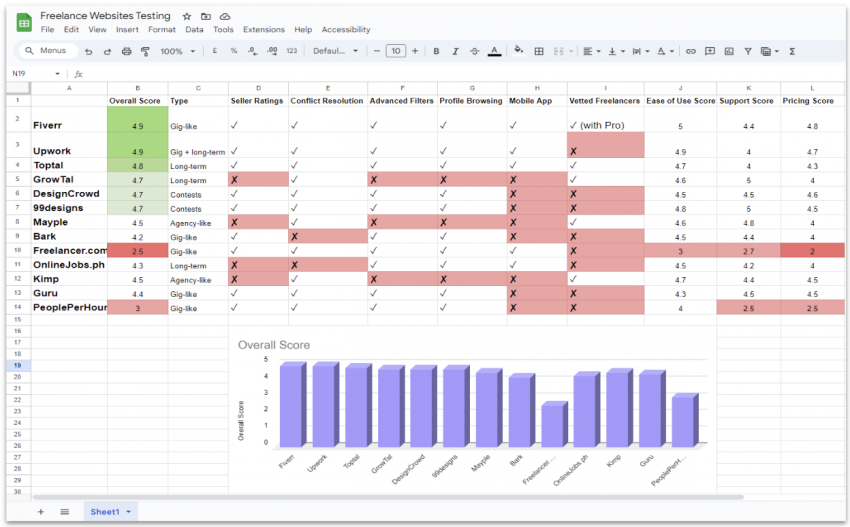
We look closely at freelancer profiles, as complete profiles can help you make better-informed hiring choices. What information about a freelancer is available at a glance? Ideally, we want to be able to view a freelancer’s current rate and examine their past work — extra points if we can access a portfolio containing specific projects they’ve been involved in.
We then check to see whether there are other hiring options, with a particular interest in job posting capabilities. If you prefer traditional hiring methods, job listings allow you to get pretty specific with your job requirements. If that’s an option, we look for easy-to-use tools that can help you filter candidates (for example, by rate or experience). We adjust our score based on how many qualified candidates apply within a set period.
We appreciate it when it’s easy to tell whether a freelancer has performed well in the past. Star ratings and success rates work, but it’s best when we can access tangible feedback from previous hirers.
Staying organized and keeping in touch with freelancers is also crucial, so we award higher scores to websites that offer great communication and management tools (such as instant chat, work diaries, and timers).

Ease of Use
Traditional hiring methods are time-consuming, so ease of use is one of the main selling points of freelance websites — and the more streamlined and straightforward the hiring process, the better. Platforms that go the extra mile to simplify things score better with us.
The user interface (UI) should be simple, modern, and easily accessible from the homepage. The filters should be laid out based on category, rate, and freelancer expertise. It’s a win if we can quickly narrow down the results by ticking a few boxes and adjusting sliders here and there.
For websites that feature job listings, we look for step-by-step procedures that guide you along the way. Are there any tips for creating optimized descriptions or attracting suitable candidates? We look at how easy it is to go through applications — even better if there’s an option to invite candidates for an interview via video/live chat.
Once we’ve found the right fit, we look at how easy it is to hire them and get started right away. We prefer simple menus that allow us to access, manage, and edit our job postings. The goal is to hire someone qualified for the job as quickly and painlessly as possible. That’s why we want to be able to view rates/prices without having to contact freelancers directly.
Finally, we check how easy communication between hirers and freelancers is. It’s crucial that we can reach out to freelancers and ask questions before we place orders or hire them. Although email, phone, and website details are all okay, we prefer it when there’s a chat option that tells us if the freelancer is currently online — and available to talk.

Pricing
Pricing structures vary significantly from website to website, and it’s our mission to figure out which platforms offer the best deals. We purchase cheap plans and packages to see whether you can get real value out of them even if you’re on a budget — or whether you’re forced to spend more.

For websites that offer ready-made projects, it’s important that we look beyond the prices themselves. Although freelancers charge different amounts based on experience and expertise, all websites charge fees on top of those rates — that’s how they make money. We check to ensure those fees are fair, both for hirers and freelancers.
For websites that allow you to post job listings, extra fees often apply. We check to see whether hirers have to pay per job they post, and/or whether there are premium plans available that allow you to post an unlimited number of jobs.
How are long-term contract payments handled? We prefer it when we can safely pay freelancers through the platform, but only if the fee is reasonable. We also check for any extra add-ons that make our search a bit easier (such as a dedicated recruiter). Are these available for a fair price, and do they get the job done?
Finally, we take a good look at the platform’s money-back guarantee — if there is one. We give higher scores to websites that offer stress-free payments by issuing quick refunds when something goes wrong.

Support
Whether your freelancer isn’t cooperating or you run into an issue with the platform itself, you need to be able to get the answers you need as quickly as possible.
We first look for help centers and FAQs — the more resources available, the better. It’s important to be able to troubleshoot common issues without relying on customer support.
We then test each website’s support capabilities by contacting its representatives through all available channels. Platforms that offer multiple options (such as live chat, email, ticket, phone) have a slight edge. We check whether it’s possible to reach the support team 24/7 by contacting them outside conventional business hours.
Live chat is, by far, the most crucial support channel, and we thoroughly test it by asking several questions. We expect live chat representatives to get back to us within 5 minutes.
Our scores fluctuate based on how quickly we receive replies and whether the answers we get are satisfactory. We expect representatives to be friendly and informative at all times.
A successful landing page can be the best way to convert curious visitors into valuable customers or leads that boost your business. To ensure that we only recommend the best possible builders, we carefully test and research every service we review based on a strict set of criteria.

Templates
High-quality design is crucial to any landing page that converts visitors effectively. That’s why the first thing we evaluate when reviewing a landing page builder is its templates. If a builder offers templates that compel us to take action right out of the gate, that’s bound to earn it a higher score.

We also take a good look at variety. Six different versions of the same hero text in different colors suggests limited design capabilities, which will make it harder to create a landing page tailored to your business and goals. On the other hand, a builder that offers a wide selection of unique-looking and attractive landing page templates will give you the freedom to create something that really stands out.
Categorization is also important. Design choices optimized to convert in one industry can fare a lot worse in others. You’re more likely to find an ideal starting point for your page with a well-organized template selection that caters to a variety of industries.
Some builders even conduct internal tests to maximize the potential conversion rate of their templates. Any builder that shows proof of high-quality research into its templates’ conversion potential will earn bonus points.
Features
The fundamentals of any landing page include a headline, some text, and a call to action button. There’s not a single landing page builder that doesn’t provide those options. However, we’re not impressed by builders that can create any landing page — just the ones that can create effective, high-converting pages.
We start by evaluating the type and quality of the editor that a builder offers. These vary from nearly limitless drag-and-drop editors to basic editors where you choose from premade sections with few options for customizing text, colors, and images.
Basic doesn’t always mean bad, though. Our primary concern is how well an editor serves its intended function. If you’re promised heaps of creative freedom, the editor should allow for nearly limitless possibilities. By the same token, builders promising quick, simple landing page creation should offer a more streamlined experience.

We pay particular attention to landing page-specific features. Visitor data management, smart pop-ups, AI tools, and advanced SEO features are all things that make us keen to award extra points to a landing page builder.
It’s also critical that you get at least basic analytics tools. Information like your bounce and conversion rates is invaluable for maximizing your conversion rate, and the quality of any such information made available will be reflected in our score.

Ease of Use
We don’t even consider a builder if you can’t launch a simple landing page in a matter of minutes. Sure, some of our favorites have a bit of a learning curve, but even then, it should always be easy to pick up the fundamentals. While creating a fully-optimized page might take a little more time, anyone should be able to master a high-quality builder with a little time and dedication.
We also assess the balance between a builder’s ease of use and features. Some feature-rich builders might take a while to master, but there’s no excuse for a barebones builder to cause you any trouble.
When it comes to optimizing your page, you’ll need to know exactly how visitors are interacting with it. The best landing page builders give you simple overviews you can read at a glance alongside more detailed data breakdowns that show you in an easy-to-digest way where you can focus your efforts to greatest effect.
Lastly, every builder should offer effective learning material to teach you how to use it. We award additional points if it offers useful guides, videos, and blogs about related topics, even if these aren’t essential to its usage. A builder that can teach you all about bounce rates, leads, and marketing fundamentals is bound to earn a higher score for this section.

Pricing
Whatever price you pay for a builder should be at least as valuable as the benefits it enables you to get from your pages. Balance is important to us. Some builders or plans might be pricier, but these should always offer the quality and features to justify their higher cost.
Our favorite builders offer a range of payment plans that cover a wide variety of needs. It’s also very rare for us to recommend a builder that doesn’t offer at least one budget-friendly option.
Some builders offer a free plan with limited features. That’s great if you want to try the builder out for yourself and see what it will let you design. We always award points for a free plan or free trial that lets you try out all of a builder’s key features before making an investment. At minimum, we expect to see a money-back guarantee that ensures you can try out the builder risk fee.
That said, if you’re paying anything for a builder, you should be able to create an effective landing page that provides reasonable scope to enhance your conversion rate. We won’t look favorably on a builder if its most basic paid plan doesn’t give you enough to achieve this, let alone if its more expensive plans don’t.
We’re also allergic to shady business practices. Fake promises, hidden costs, and/or constant upsells will always result in points being docked.

Support
A landing page needs to be fine-tuned if it’s going to maximize your conversion rates. That’s why it’s important to have access to a helpful and efficient support line that can answer any questions that could affect the quality of your page.
When evaluating a builder’s support, we start by taking the number of support channels into account. The more, the better. We also pay close attention to response times. If support takes five hours to get back to you, that “burning” question might as well have burnt out by the time you get an answer.
Another thing we consider is availability. No one gets to decide when their next pressing problem will arise, so ideally, a builder should offer at least one line of support with 24/7 availability. That said, we also understand if a builder provides support within (reasonable) business hours.
We test the customer support of each builder we review multiple times. It’s important that the experience is not only helpful but pleasant as well. Ideally, the support staff will demonstrate a deep knowledge of the builder and explain complex concepts in simple terms with a friendly tone.
We put each form builder through rigorous testing and assess its performance in five key areas: templates, features, ease of use, support, and pricing. We carefully note how the builder performs against a checklist of criteria, keeping track of all pluses and minuses.

Templates
Some form builders offer thousands of templates, while others provide just a few. That said, while a good template selection with plenty of designs and styles will always earn higher points, we consider other factors, too.
Having templates that suit a range of business, personal, and educational purposes is important. We also note whether the form builder offers both one-page and multi-page forms and if these have multiple fields or make it easy to add them.
As well as the templates themselves, we also explore the template library to see if forms are organized into easy-to-search categories that let you find what you need quickly, whether that’s forms designed for gathering leads or accepting payments.
Additional points are awarded if you can add new fields to a pre-designed template, change the order fields, and add/customize descriptive text to gather specific information.
Ultimately, the more flexibility and choice a form builder’s templates offer, the higher the score we’ll award.
Features
A key consideration in how we rate form builders is the range of options you get for collecting exactly the data you need. The more options you get built in, the better. At a minimum, we expect to see a decent variety of form fields available and a basic set of reporting tools for reviewing the data you collect.

Ideally, a form builder will also offer more advanced features, either built in or by integrating with third-party apps and widgets. Additional tools for data management, payment processing, email marketing, and data analytics will attract a higher score.
A form builder that works with popular CRM (customer relationship management) and communication tools like Salesforce, HubSpot, or Slack would also score higher, as would one that offers a mobile app that lets you create and share forms and collect and view submissions on the go.
We also vet form builders on security features, taking note of any specialist features designed to support businesses operating in industries which handle sensitive data, such as healthcare and financial services. Compliance with Level 1 PCI, HIPPA or GDPR standards will earn bonus points.

Ease of Use
Virtually every form builder claims that it’s “easy to use,” but many fall short of this claim. That’s why we test each form builder we review to determine if it meets our benchmark for user-friendliness. Anyone should be able to choose a template, customize it, and quickly access all the form builder’s features without needing to have previous experience or coding knowledge.
Breaking down our process further, we vet form builders on whether they have an intuitive interface and on how easy they make it to add and rearrange elements, with simple drag-and-drop editors typically earning the highest scores.

To ensure our conclusions can be relied upon by a range of users, our expert reviewers build multiple forms with each of the form builders we test. As they do so, they evaluate how easy or difficult it is to create and personalize a form for different purposes, whether that’s gathering leads, accepting payments, collecting answers to surveys, or launching a product.
To complete the process, we test how easy it is to share a form, taking note of how many share options the form builder offers. Plenty of easy sharing options (e.g. email, direct link, text, social media) will mean a higher score.

Support
When evaluating the quality of customer support, we first look at the variety of support options available. We consider live chat and phone support to be the most important, but friendly and responsive email and ticket support will also earn points.
Equally important are the hours during which support is available. Are support options limited to business hours only? Or can you expect a prompt helpful response even if you run into a problem at 10PM or on the weekend?
In the end, the only way to really know how good a form builder’s support options are is to actually test them. That’s why we contact each form builder’s support team with a question a typical user might ask, taking careful note of how quickly we get an answer and how knowledgeable and helpful the support representatives are.
We also consider whether a form builder limits certain support options to paying customers only, or even just those on higher-tier plans. For example, if users on a free plan or free trial can only access a community forum or knowledge base, this would usually result in a lower score.
Finally, we explore any articles and video tutorials in the form builder’s knowledge base (if it has one) to see how comprehensive, helpful, and up to date these are.

Pricing
When we evaluate pricing, our primary focus is always “value for money.” We know that our readers have different budgets and don’t all need the same features to accomplish their goals. Whereas one user may be better off with a budget-friendly form builder that does the basics well, another might benefit from investing in a feature-packed builder with a premium price tag.
Among the first considerations we weigh up when evaluating plan pricing are the number of forms you can create and the number of submissions you can receive at each price point. Depending on how these compare to the market standard, we’ll award or dock points accordingly.
Ideally, every form builder will offer a free plan or free trial so you can explore all of its features before making a commitment. The longer and more fully featured this opportunity to trial the builder is, the more points we’ll award. If a free plan is so limited that almost all users will have to upgrade to a paid plan at some point, this will result in fewer points being awarded. At a minimum we expect a money-back guarantee that will let you test the form builder risk free.
When performing our tests, we also pay close attention to whether the overall quality and feature-set a builder offers is worth the money it costs. In many cases, a less expensive builder will outperform a high-priced competitor in terms of the overall building experience, ultimately earning a higher score in this section for the better value for money it offers.
We start our review of any social media management tool by trying out every function for ourselves. We test social media management software on its capabilities, how easy it is to manage your profiles, its value for money, and the reliability of its customer support.
Features
A good social media management tool will let you connect and manage multiple profiles across multiple platforms, such as Facebook, Google, Twitter, and Instagram. The more you can work with, the more points we award.

Next, we test the tool’s social inbox, which lets you handle all social media interactions in one dashboard. We award points for how many engagement options there are, like being able to boost posts, respond directly to messages, and retweet from your dashboard.
We also like to see filters, so you can sort posts by type and focus on one thing. We take off points when a social media tool limits options, like hiding older messages.
Monitoring your social media accounts is key to running a successful campaign, so we examine how in-depth the tool’s social listening and reports are. We award points when a social media tool lets you track trends like keywords, hashtags, mentions, and competitor posts. Social listening gives you insight into how people feel about your business, as well as how you compare to others, so it’s very important.
Finally, we look at scheduling and posting. We use the tool to write posts, then test what we can do with them. We like to see attractive auto-formatting, accurate preview options, and intuitive post-scheduling so you can take advantage of planning out your strategy ahead of time.

Ease of Use
Social media tools are meant to make managing your social media campaigns easier, so the software itself should be user-friendly. The first thing we do is set up an account with the platform — we give points when setup and linking social media profiles can be completed in a few simple steps. We take away points from tools that add unnecessary steps. The fewer clicks, the better.

Setting up scheduled posts and auto-sends should also be easy. We award points for intuitive dashboards and handy tools like a drag-and-drop calendar to manage your social media schedule. Bonus points if the social media software gives you a media library, which you can use to add royalty free images to your posts.
We like to see quality-of-life features like customer service chatbots and the ability to save custom replies, so you can interact with more people with a click of a button. FAQs and guides to selling through your social channels are other helpful features we award points for, as they make it so much easier to engage with customers.
If you’re a social media manager working with multiple client accounts, it’s essential to be able to organize social media accounts into groups. We test how well a social media tool handles account grouping based on how easy it is to add clients and work on multiple profiles at once.

Pricing
Whatever your budget, we look at whether you get value for your money. Bonus points if you get a free trial to try the software out first. If a social media tool’s plan costs more than competitors, it must give you extra features to make up for it. Usually, that means more users, more scheduled posting, and more social media profiles.
We like to see plans that offer unlimited scheduled posts, to help you stay organized and in control of your social media profiles and platforms. We give more points to social media tools that let you connect more profiles for less. Some platforms restrict how many profiles you can have with cheaper plans (I’ve seen as low as 5), so we remove points for that.
Finally, we look at a social media tool’s refund policy. If a social media marketing tool isn’t increasing your engagement or making your campaign better and easier to manage, you should be able to cancel without any hassle. We check for refund options and warn you if all payments are final. At the very least, we want to see a prorated refund, so you don’t have to pay for unused days after canceling.

Support
For when things go wrong or you need help using your social media tool, support is (hopefully) there to save the day. We give more points to platforms that offer a variety of support options — we look for email, ticket, live chat, phone, help wizards, and documentation. If a social media tool only offers one or two forms of support, we take off points.
Since tragedy can strike at any moment, operating hours are also important to us. Not only do we look at and compare hours of operation, but we also put claims of “24/hr support” to the test. We’ll test out the live chat or send an email outside of business hours. The faster a support agent gets back to us, the more points we award.
We test how helpful the support is by giving them a few questions via email and live chat. If they answer our questions and provide a solution, they pass the test. More points go to detailed responses, step-by-step guides, and helpful links to documentation.
Our evaluations of cloud storage and backup providers offer an overall score out of five, based on the average of the scores in six categories: features, ease of use, performance, privacy, support, and pricing.
Features
While online backup and storage is a very straightforward service, there are a number of variables that need to be considered to establish whether a given cloud storage provider is worth your money. Can backups be scheduled? Are they continuous and/or automatic? Can backups be performed on an external drive? Is there a physical courier service?
What operating systems are supported? Windows, Mac OS, and/or mobile OSs?
Of course, backup services are only useful with a robust data restoration policy. What options for restoring data are there? Is there any file retention? Is there a physical courier service available?
Finally, security is of paramount importance. We include details of encryption methods, and a review of the vendor’s security policy.

Ease of Use
To establish the user-friendliness of a given storage service, we go through the setup process, documenting the purchase and signup process as well as the uploading process itself.
We explain how to choose between continuous, scheduled, or automatic backups, and whether these options are even available. We also clarify the degree to which the user can control what is backed up.
Finally, we list all interfaces offered by the vendor, such as mobile apps or browser extensions, and we compare these various options with the primary one, such as a desktop app.
Performance
For our performance testing process, we begin by uploading 3GB of data, which consists of a range of large and small documents and images. We perform this process at three distinct times — a day and an evening during the week, and once on the weekend.

During this process, we record the speed of uploads, access, and downloads, taking into consideration any environmental factors such as the bandwidth of the available internet connection and the distance from the data center.
We take careful notes on device performance during the file restoration process, and we subtract points if the backup slows down the computer or mobile device significantly.
Privacy
In an era of emerging privacy regulations, our readers want to know the details of a company’s privacy policy before they store any kind of data with them — digital documents in particular.
Does the storage provider use or share data, whether with third parties, or in response to court orders, law enforcement, and government agencies? Does the vendor offer plans that support FERPA, GLBA, and HIPAA privacy regulations?
Do regional or national laws or other regulations affect the service’s privacy policy? For example, data centers in the USA are under the jurisdiction of the Patriot Act and the Five Eyes intelligence alliance.

Support
We contact the storage service’s support team posing as ordinary users with legitimate questions or requests for help. We don’t ask about things that can easily be found on the site, or that readers won’t find helpful.
We establish all the available support channels on offer from each vendor, and whether they are available outside of regular business hours or not.

Then, we communicate with the support team using more than one available channel, if possible, and document the results. Were the support agents prompt, helpful, and/or knowledgeable? We provide examples of our interactions as well so that readers know what they can expect if they choose a backup plan from a given vendor.

Pricing
We present an overall impression of the vendor’s pricing, with an emphasis on value for money rather than just low pricing. Is it a budget or premium host, or does it offer a range of plans that could be classified under both of these categories? Are the prices competitive within these categories, or for the specific type of plan?
We summarize the various types of plans on offer, and highlight the best or most notable offers. What are the payment options? Do you pay for the amount of data you back up? Can you pay for unlimited backup? Is there a distinction between personal and business accounts? How many users or devices are allowed in each plan?
Is there a trial period or a money-back guarantee? How does it compare to the rest of the industry?
We review each project management software based on five criteria listed below. For each of these, we aim to give our readers a clear understanding of the software’s strengths and weaknesses, who it’s best suited to, and what makes it unique. Finally, we calculate the platform’s overall score for a quick overview of how it compares to the competition.
Features
Keeping the reader’s interests and pain points in mind, we evaluate all of the key features the PM software offers. Rather than merely listing available tools, we make sure to provide some analysis of each feature we include, taking care to explain how it benefits the user. This helps our readers better understand how the platform differs from others and how well it caters to their particular needs.
We focus on features likely to be of most value to our readers, including project views (different visualization methods), automation tools (to save time on repetitive tasks), and range and quality of integrations with other software (for additional functionality). We also highlight any unique features the PM software may have that helps to distinguish it from others.
Our final score for this section depends on how comprehensive, flexible, and effective the platform’s features are. For instance, PM software may be awarded points if it has useful tools like time tracking and document storage built-in, as having diverse tools included in a single app helps users streamline their project management in one place.

Ease of Use
Every PM software claims to be user-friendly, but this isn’t always the case. That’s why every reviewer extensively tests the PM software for themselves, making sure to get plenty of hands-on experience with its full range of features. This gives them direct insight into how easy to use the platform really is, including how easily a complete beginner can set up a basic project.
To appeal to users of different levels of expertise (including beginners), it’s essential for PM software to have an intuitive interface that’s easy to navigate. All the options should be easy to find rather than being hidden under layers of confusing menus. Also, having on-screen prompts that help users get started with the platform will earn it a higher score.

Finally, we highlight any dedicated ease-of-use features the software offers, such as the ability to organize tasks or generate reports with a single click.
Collaboration Tools
Providing various ways for teams to coordinate and connect can hugely increase productivity. Therefore, we spend extra time testing a PM platform’s collaboration features to see how easy it is for team members to communicate and provide feedback.
Some of the useful features we typically look for include a built-in messaging app for real-time communication, the ability to leave comments and @mention colleagues, and customizable dashboards that give everyone insight into the team’s progress.
Additional tools that can earn the software bonus points include file sharing and mobile app capabilities. Good PM software should give you multiple ways to upload and attach files to make information sharing as frictionless as possible. And a fully-featured mobile app is important for allowing users to collaborate on the go.

Pricing
Our first goal in this section is always to clarify the PM software’s pricing structure for the reader. We detail the software’s free plan (if available) and all available paid plans. We also discuss the potential limitations of the free plan and the cheaper paid plans, as well as highlighting any essential or important features that are only accessible on more expensive plans.
Our second goal is to assess the value-to-price ratio of the various plans and establish which plans offer the best value for different kinds of users. We are upfront about whether the software is cheap or expensive overall, comparing its prices to those of similar platforms. This can help the reader decide if it’s the best value option for their needs.
When scoring this section, we pay most attention to the overall value-to-price ratio the various plans offer, considering what functionality the user gets at each price point, and whether they’ll be forced to upgrade quickly. For example, a feature-rich free plan or premium features like Gantt charts or free collaborator seats on lower-tiered plans will earn a higher score.

Support
Even more experienced users are likely to need some help using their PM software. That’s why we consider at least one direct customer support channel to be a must for the platforms we review.
Our team makes sure to test every platform’s live support channels, which typically involves contacting a support agent via live chat, email, and over the phone. If only one support channel is available, we test it at least twice to get the most accurate information.

When evaluating support, we take account of the number of available support channels, with multiple options, and live chat in particular, earning more points. Bonus points are given for 24/7 availability and quick response times during our tests. We also consider the helpfulness of the customer support agents, noting how effectively they address our questions.
Many users prefer to solve problems on their own, so we also award points if a platform comes with a well-resourced knowledge base. When evaluating this, we look to see how extensive and well-organized help resources are, how easy they are to follow, and how regularly they’re updated. The more of these boxes we can tick, the more points we award.
We research and assess each credit card processing service using the five criteria listed below. Our expert team publishes in-depth reviews that are backed by careful analysis of each vendor’s website, customer reviews, and individual experiences.
Features
Every payment processor claims to offer the best solutions for a wide range of industries. However, we know that there are no one-size-fits-all solutions to payment processing. The features a business needs will depend on its model, sales volume, industry, budget, and more.
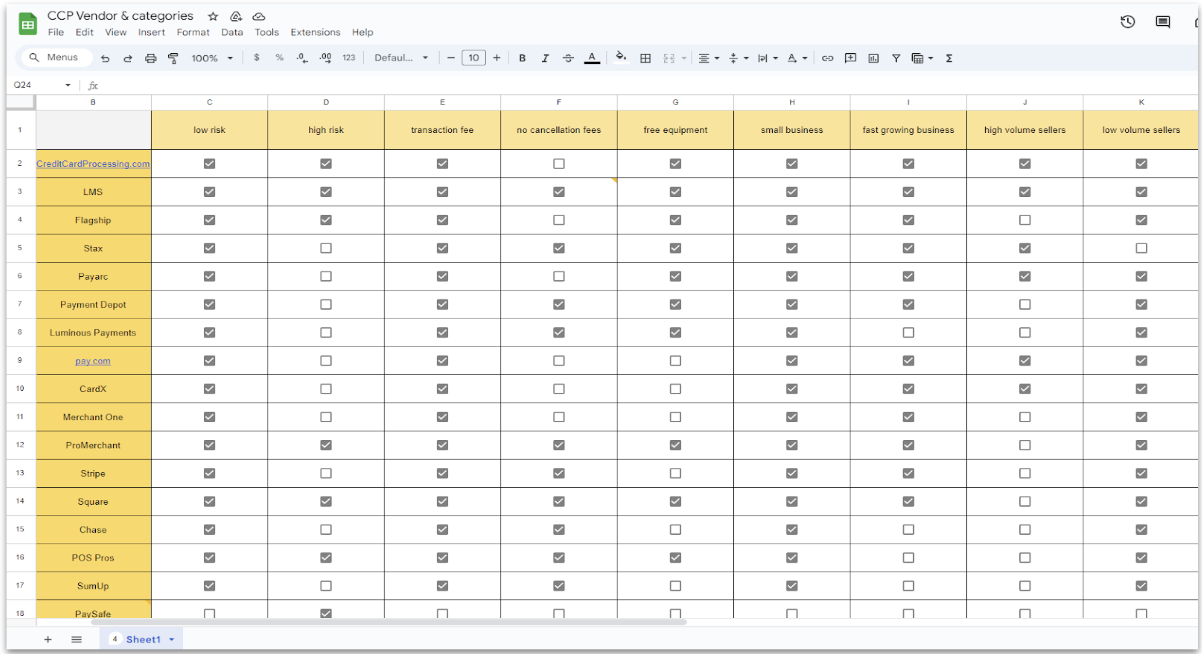
At minimum, we ensure that a payment processor offers something for every payment type. From there, we assess each feature individually. Many CCPs will offer third-party tools (such as Authorize.net and OpenCart) for everything outside of in-person payments, so we research each tool to ensure that it offers a good range of features and integrations. If there’s a lack of variety in software tools, or there’s a significant feature missing, then we’ll dock points.
We also check to see if there is any free point-of-sale (POS) hardware on offer. While we don’t dock points for a lack of free hardware, we always note this in our review as it can affect the initial cost you’ll need to pay to start processing payments with a specific CCP.

Ease of Use
Payment processing is a vital part of any business, and no one wants clunky software or an uphill battle to apply for an account.
We take a look at the application process to see what documentation merchants need, how long the process takes, and how long merchants can expect to wait once their application is submitted. We’ll also check customer reviews to see whether that figure is accurate and what support was provided during the process.
From there, we’ll check if the software the CCP offers is easy to use, and we’ll dock points for software tools known to have usability issues. We also look into how easy it is to integrate the processor with an existing e-commerce store or POS hardware suite and if it offers any assistance with this during the onboarding process.

Pricing
It’s often difficult to assess pricing as very few credit card processors are transparent about their fees. So, we take this opportunity to contact customer support and get a quote for a low-risk business. This allows us to assess a processor’s transparency and support in one go. We’ll dock points if customer support won’t discuss the entire fee structure unless the merchant applies for an account.
Once we have some figures in hand, we’ll analyze the pricing model of the processor to determine what types of business it’s most suitable for. We’ll also check each fee against competitors to help determine whether the CCP offers good value for money.
Even if the processor provides a full quote, we’ll look at customer reviews to see if there are any complaints about hidden fees or unexplained charges.

Compliance & Security
It’s a legal requirement that payment processors and merchants are PCI compliant, so this is the first thing we check for. As part of this, every CCP must have a basic level of built-in security to protect merchants and their customers. This will depend on the “level” of PCI compliance that they are required to have, so we’ll add points for Level 1 PCI-compliant CCPs.
We also see if CCPs help merchants with their PCI compliance, as this can be a confusing process for new merchants in particular. We’ll then look to see whether a processor is compliant with any other security legislation like HIPAA, GDPR, or ISO. If so, this is a good sign that the company takes data security seriously, particularly if it isn’t legally required to follow these standards in the jurisdiction it operates in.
Finally, we assess the quality and comprehensiveness of any fraud or chargeback support the CCP offers, taking into account whether these are built in or provided by third-party tools. We also award bonus points for any “above and beyond” security features a CCP might offer, such as a dedicated fraud monitoring team.

Support
Even the most experienced merchants will need to contact their payment processor from time to time, so we take practical steps to determine how accessible, friendly, supportive, and knowledgeable a CCP’s customer support team is. The first thing we do is take stock of how many support channels are available. We award points for 24/7 support, particularly if it’s available via phone or live chat.

For each available channel, we measure how long it takes to receive a response. If we receive a reply or get through to a live agent, we evaluate the quality of the support given.
Does the agent answer our question clearly? Does it sound like they’re speaking from a script? Do we feel under pressure to make a decision? We’ll dock points if we have to wait a long time for a response, particularly when testing a phone or live chat channel. For 24/7 support, we’ll test these channels multiple times during the day to see if this affects response times and quality.
We’ll also award points for a knowledge base with support articles, video tutorials, setup guides, and an FAQ page covering common questions. The more comprehensive these resources are, the less merchants will need to rely on customer support to resolve any issues that arise.
We evaluate and rate each LLC (limited liability company) formation service based on the criteria below. These criteria are meant to help you, our reader, better assess whether a service is the best choice for your needs and level of experience.
Features
When evaluating LLC services, we look at what features they offer and whether they deliver value to customers. The best services offer a range of features, including valuable complimentary add-ons and fast filing or expedited services.
While features vary from one service to the next the main requirement for an LLC plan in the US is the preparation and filing of the Articles of Organization with the state. Beyond this, an Operating Agreement, Banking Resolution, and EIN registration are useful must-haves, especially for multi-member or multi-employee LLCs. Money-saving extras, such as compliance notifications and assistance, are a bonus.
Apart from this, we also consider additional services that the LLC service provides. For example, can it act as a Registered Agent for business owners who operate out of state or internationally? Can it handle bookkeeping, taxes, Annual Report filing, or apply for licenses, permits, trademarks, patents, or copyrights? Even better if one or more of the above is included in an LLC formation plan.

Ease of Use
A user-friendly sign-up process is a must for new and experienced business owners alike. We look for services that help newcomers make sense of the terminology and processes involved while delivering an easy, fast, and stress-free experience.
The best options make the process of forming an LLC easy by taking the complexities off customers’ hands. We consider how long it takes to sign up for an LLC formation package from each company, including navigating any upsells and filling in forms. Additionally, we examine how long it takes the company to file and return the documents to customers, taking into consideration that it is often affected by how long the state takes to process the documents itself.
Finally, we take note of the simplicity and user-friendliness of the forms, tools, dashboard, and app. For example, how easy is it to navigate and use them, and are there any technical issues? If so, can we request pre-sales support via live chat or a 24/7 hotline? The languages the LLC service offers assistance in are also an important factor.

Pricing
LLC services typically price their plans based on the included features, market trends, and competition. Naturally, pricing is a big consideration when we evaluate LLC services, with excessively costly services not being shortlisted. However, value is also important. We don’t just look for “cheap” services, but ones that give customers close to, or more than, what they pay for.
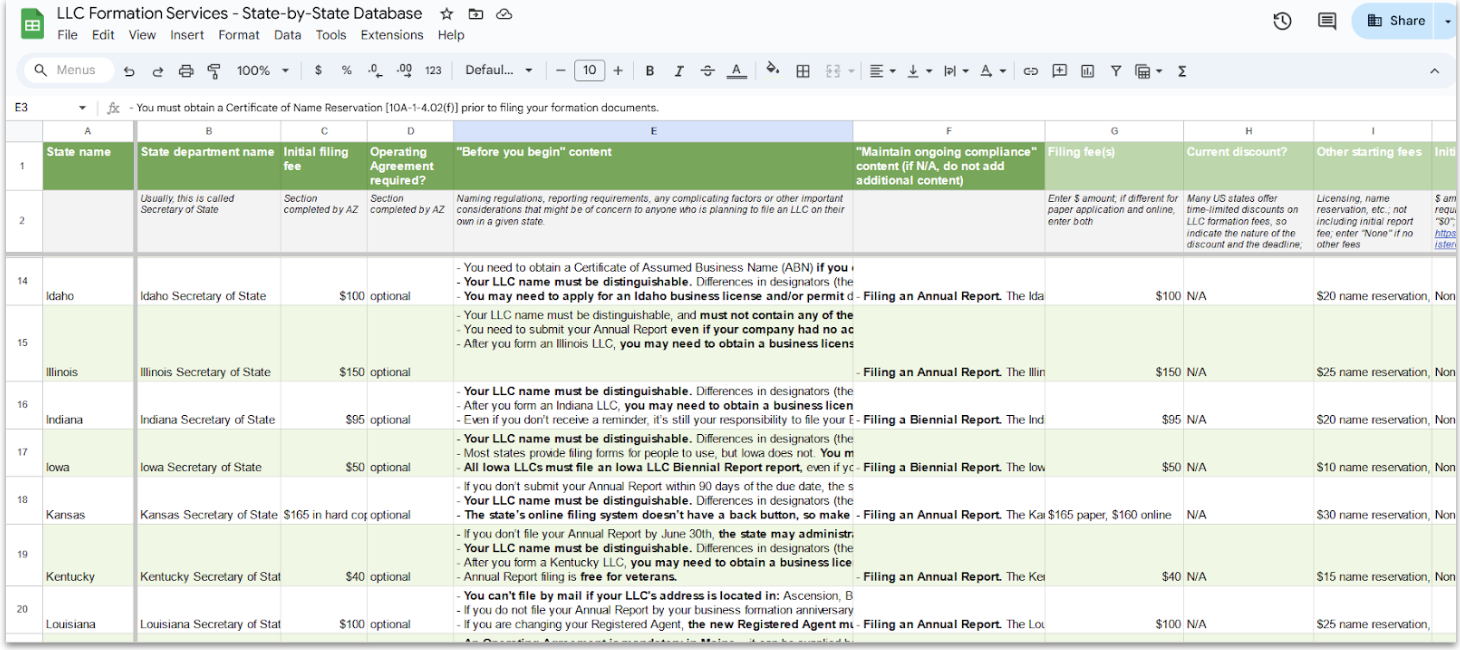
That said, incorporating in the US is free via most official state sites (mandatory state fees notwithstanding). Therefore, we take note of any LLC services that offer free LLC formation and accuracy guarantees. Lastly, we look at whether LLC service charges on a subscription basis (monthly, annual, etc.) or as a once-off fee. We also take note of any misleading pricing or dubious business practices. For example, are there pre-selected upsells, fine print, or hidden fees that may dupe customers into paying more than they were initially quoted?

Support
Support is a critical – yet often overlooked – aspect of an LLC service. You’re not just signing up for a streaming platform or a meal kit subscription box. You’re forming a business that requires adherence to certain regulations and laws which, if broken, are punishable by fines, blacklisting, or even jail time. The LLC service’s support – both pre-sales and customer – must be able to guide you on the correct path and quickly identify any issues with your application.
From a technical perspective, we consider the range of support channels and hours. For example, are they available 24/7/365 or simply during business hours? We also contact each LLC service’s support team via at least two support channels to find out how responsive, knowledgeable, and helpful they are.

To further ensure they’re worthy of a high rating, we research the LLC service’s reliability and reputability. How does it fare in real customer reviews, and what is its Better Business Bureau accreditation and rating? These ratings provide insight into a company’s overall quality of service that can’t be gleaned from a simple feature list or pricing plan.